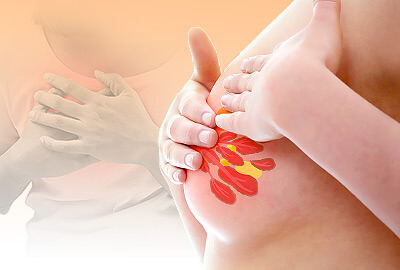Breast pain, also known as mastalgia, refers to the general discomfort, tenderness, or pain in one or both breasts. The leading cause of breast pain is hormone fluctuations, specifically of estrogen and progesterone. These hormonal shifts - which typically occur during menstruation, pregnancy, and menopause - cause inflammation of the breast tissue, resulting in pain. Continue reading for the most important things to know about cyclical breast pain.
Types Defined
There are two types of breast pain, cyclical and non-cyclical. Cyclical breast pain is recurrent and also the most common because it is directly linked to periodic hormonal fluctuations. Cyclical breast pain can range from mild to severe, and can last anywhere from a few hours to several days. Contrary to popular belief, breast pain is rarely a symptom of breast cancer.
Common Symptoms
Common symptoms of cyclical breast pain include tenderness to touch, lumpiness, sharp stabbing sensation, burning, swelling, and dull aching. Breast pain affects as many as 70% of women at some stage of their lives. Of those 70%, about 10% of those women experience severe breast pain, which can interfere with daily life, relationships, and activities.
Other Causes
As previously mentioned, hormone fluctuations typically trigger cyclical breast pain. However, there are several other potential causes of cyclical breast pain. These include lifestyle and physical triggers that can contribute to breast pain in the face of hormonal imbalances.
Stress. Stress is a trigger for many menopausal symptoms because when you are overly stressed, you are susceptible to pain, weight gain, and getting sick.
Exercise. Unfortunately, exercise has been shown to induce breast pain, especially for women with larger breasts. However, it should be noted that exercise will help in the long run, and you should continue to do so regularly. Wearing a properly-fitted sports bra will help reduce breast pain during exercise.
Certain medications. Breast pain is a common side effect of certain medications like oral contraceptives, heart medications, and antidepressants.
Previous surgery. Breast pain may linger from previous surgical lesions that may still be healing.
Breast size. Women with larger breasts are more likely to experience breast pain than smaller breasted women. Getting properly fitted bra size is highly recommended to prevent breast pain.
Diet. A poor diet can cause breast pain. It is important to maintain a healthy and balanced diet with sufficient vitamins and nutrients.
Cyclical breast pain is the most common type of breast pain, and is typically caused by hormone fluctuations - specifically of estrogen and progesterone. It is important to note that breast pain is rarely a sign of breast cancer; in fact, only 2 - 7% of women with breast cancer experience breast pain. Mastalgia can be managed by simple lifestyle changes and over the counter medication like ibuprofen. If, however, breast pain persists, worsens, or you see any sign of infection like nipple discharge, you should contact a doctor.
Sources
- Mason, B.R. , Page, K.A. & Fallon, K. (1999). An analysis of movement and discomfort of the female breast during exercise and the effects of breast support in three cases. Journal of science and medicine in sport, 2(2), 134-144. Retrieved from http://www.ncbi.nlm.nih.gov/pubmed/10476977
- National Health Service UK. (2012). Cyclical breast pain. Retrieved July 24, 2014, from http://www.nhs.uk/conditions/breastpaincyclical/pages/introduction.aspx
- Reynolds, G. (2014). The Problem of Breast Pain in Women Who Exercise. Retrieved July 24, 2014, from http://well.blogs.nytimes.com/2013/05/01/ the-problem-of-breast-pain-in-women-who-exercise/?_php=true&_type=blogs&_r=0
- University of Maryland Medical Center. (2012). Breast pain. Retrieved July 24, 2014, from http://umm.edu/health/medical/ency/articles/breast-pain




